eISSN: 2469-2794


Review Article Volume 8 Issue 3
Science and Technology, Nottingham Trent University, United Kingdom
Correspondence: Andrew O’Hagan, Nottingham Trent University School of Science & Technology, Erasmus Darwin, Room 230, Nottingham Trent University, Clifton Lane Nottingham NG11 8NS, Direct Line 01158483153, UK, Tel 07850875563
Received: May 18, 2020 | Published: May 26, 2020
Citation: O’Hagan A, GillDoes the use of illicit drugs specifically class a drugs influence the crime rate? Forensic Res Criminol Int J. 2020;8(3):104-112. DOI: 10.15406/frcij.2020.08.00313
Class A drugs are very potent substances with lethal side effects; they are considered the most dangerous of illicit drugs. The crime rate over the past decade has shown a rise and fall in the quantity of crimes committed due to drugs. Illegal drug traffickers, smuggling heroin, cocaine and other substances into the UK, Europe and U.S; are enticing more younger adolescents to join the craze. These traffickers conceal and manipulate their way into countries such as the UK where demand is always expanding. This paper will explore whether or not drugs, specifically Class A have an effect on the crime rate. In this paper, results are shown to indicate a minor positive correlation between the relationship of drugs and the crime rate; there is still a large proportion of uncertainty on the title at present. This review provides an outline of the typical users of drugs, how cocaine and heroin is trafficked into Europe and data concerning the link between drugs and the ever-rising crime rate.
Keywords: crime rate, cocaine, heroin, legislation, class a, economic compulsive, psychopharmacological, systemic, drug law
Illicit drugs are a major influence on the crime rate in the United Kingdom, these substances fall under two categories,1 the first covering the main illegal drugs; taken merely for the recreational feeling of ‘getting high’ these drugs include: Cocaine, Heroin, MDMA and LSD. The second category comprises the legal drugs consumed once prescribed by a doctor; however, these drugs are exploited by the individual they were prescribed to and even users who are not under the doctor’s care. The drugs in this category include: prescription painkillers and sedatives, for example Codeine, Morphine, Valium (Diazepam), Halcion (Triazolam) are to name a few of the more common ones. Many of the first category are consumed in England due to drug trafficking from overseas countries i.e. Columbia and Afghanistan.2
‘Drug trafficking is a global illicit trade involving the cultivation, manufacture, distribution and sale of substances which are subject to drug prohibition laws’.3 Cocaine is the most commonly used illicit stimulant drug across Europe, with an approximation of 3.6 million adults using the substance,4 the drug itself is a natural product isolated from the leaves of Erythroxylum coca Lamarck and Erythroxylum novogranatense (coca leaves). This drug is mainly cultivated in South American countries of Bolivia, Colombia and Peru and is trafficked to Europe via both sea and air; predominantly being shipped from Brazil, Ecuador, Venezuela and Argentina to then arrive in Europe to be distributed to the UK.5
As well as Cocaine, Heroin is a frequent substance used by adults in the UK; the opioid makes the user feel a sensation of euphoria, causing the addictive nature. This substance is derived from the morphine alkaloid contained in the natural source: Papaver somniferum (opium poppy).6 Afghanistan is the capital of Heroin production and is exported into Europe via 4 main routes: The Balkan Route, Southern Route, Northern Route and the Caucasus Route.5 Both substances are Class A drugs and the possession of these illegal highs can give the user a maximum of 7 years in prison,7 they both are easily accessible on the street and are highly popular due to the intense feelings of pleasure.
This review provides a highlight of the topics mentioned, overall there will be a discussion on the previous history of the crime rate, the potential users of Class A drugs, cocaine and heroin trafficking; as well as potential factors of drug crime and whether drugs do have an impact on the crime rate.
History of the crime rate in UK
Crime rate has fluctuated over the past decade, however towards the end of 2018; a rise in crime has once again been observed.8 The offences considered are shown in Table 1 below.8 According to the Crime Survey for England and Wales, a 4% decrease has been shown in the number of police recorded offences involving firearms; this may be due to stricter government laws i.e. Firearms Amendment Act 2018.9 This act came into the police force to use on the 16th October 2018,10 Section 1(a)(i) and (a)(v) states to ‘create offences for possessing, carrying and using firearms in public places and private property’ and that it is an ‘offence for possession of parts and equipment for the purpose of manufacturing firearms’ by amending these rules of the Firearms Act later in 1997 and thus further on in 2011, the government has made it very difficult for person(s) to traffic firearms into England for gangs to use and associated fugitives. In 2011, The Violent Crime Reduction Act11 was amended to specify how imitation firearms must be regulated; Section 4(a) states ‘an imitation firearm must incorporate an inclusion’ this was used to stop dummy firearms being modified to then be sold onto the highest bidder for the use of violence.
Offence |
Percentage increase/decrease (%) |
Vehicle offence |
3% |
Robbery |
17% |
Burglary |
-1% |
Shoplifting |
-1% |
Homicide |
14% |
Offences involving firearms |
-4% |
Offences involving knives/sharp instruments |
8% |
Assault using a sharp |
15% |
Table 1 Offences and the percentage increase/decrease
As firearms offences decrease, the use of knives or sharp instruments has increased; an 8% increase in offences involving knives and a 15% increase in the number of admissions to hospital in England for assaults involving a sharp instrument8 Most police forces have seen a rise in knife crime since 2012, alongside this the jobs of Police Community Support Officers have been reduced across the country. Table one indicates the percentage increase and decrease in various crimes.
Table 1 Offences and the percentage increase/decrease.
Who uses drugs? Why is there an increase in the consumption of drugs?
According to the National Statistics for 2012/13, in England and Wales; adults as young as 16 are contributing to the use of an illicit drug. A key stat represented from this data is that, 2.6% of adults aged 16-59 had taken a Class A drug in the last year (2012).12 This 2.6% may seem like a menial percentage of the overall population for England and Wales; however, it is equivalent to almost 850,000 people. Cocaine and ecstasy were the most used Class A drugs with 1.9% of people taking cocaine and 1.3% taking ecstasy. In Figure 1, the graph represents the percentage use of any drugs and Class A drugs across the age ranges of 16-24 and 16-59. This data was taken from 1996 through to 2012/13. The data presented in Figure 1 shows, all 4 categories have decreased in the percentage of drug use over the 17-year span.
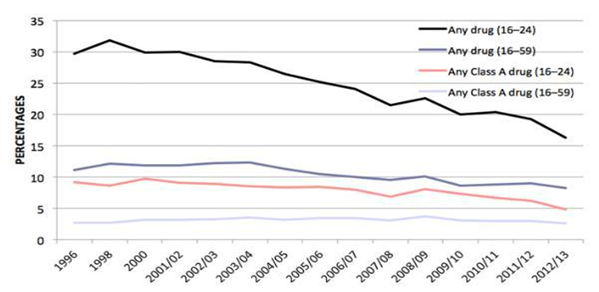
Figure 1 Trends in illicit drug use (excluding mephedrone) in the last year among adults – 1996 to 2012/13.12
A study with National Statistics was also conducted into the amount of frequent drug users; (frequent meaning, once a month). The information displayed in Figure 2 shows the percentage of drug users aged 16-59 who admitted to taking Class A, B or C drugs in their lifetime; compared to just in 2012/13. From the graph we can say that the most common drugs taken by frequent drug users in 2012/13 are: Any type of cocaine and cannabis. However, the most common drugs taken by frequent drug users aged 16-59 in their lifetime were: Any amphetamine and LSD.13–16
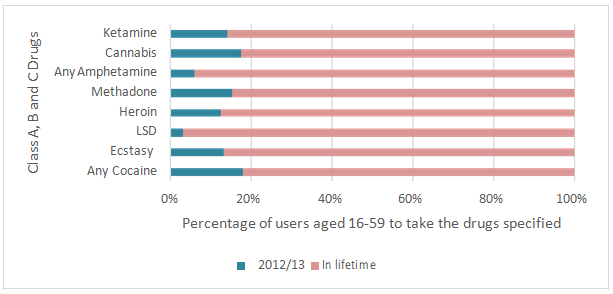
Figure 2 Percentage of 16 to 59 year olds classified as frequent drug users by substance.12
This data was taken from 1996 through to 2012/13. As seen from the data in Figure 1, all 4 categories have decreased in the percentage of drug use over the 17-year span.
A survey conducted through the Guardian in 2014,17 recognised that the Class C drug, marijuana, is shown to be the most popular drug used first by the population. With 82% of England stating marijuana was their first illegal drug consumption. Marijuana is often referred to as the gateway drug and a potential factor in the increase of drug consumption, there is not compelling evidence that this is true; however, it is believed that early exposure in adolescents to such cannabinoids can cause particularly harmful effects such as addiction and use of harder drugs.18
In 2014, a study was undertaken by the Guardian, it showed that in the last year (2013) the number of drug users in the population of England and Wales had risen from 230,000 to 2.7 million- a drastic escalation. This rise comes after a decade, where people believed that drugs were ‘un-fashionable’ and if these substances were taken they would not ‘fit in’. An understanding of this is particularly due to the way celebrities behave; they are constantly in the glare of publicity and a lot of the population feel they should conform similarly to that of a celebrity to be cool. In 2010 it was shown that a number of adults taking illicit substances was around 8.6% of the population, this was the lowest percentage since the study had begun in 1996. During this time, many popular celebrities were regarded as positive role models that did not use drugs. This could have been a reason as to Why the population’s drug use dropped as they were not influenced to it over social media, unlike today’s society. On the other hand, the celebrities who were known drug users merely appeared as out dated in the public eye.
In 2013 it was reported that Class A drugs had become ‘cheaper than the average pint’. From this one statement, it is evident why the use of drugs arose in 2013. Both cocaine and heroin had decreased by £9 a gram between the years 2005 and 2010; possibly due to lack of buyers in that decade. By lowering the prices of these substances, young adults who are intrigued and enticed; only think that its cheap and that they can have fun, whereas they do not think about the harmful consequences to follow.
Figure 1 – Trends in illicit drug use (excluding mephedrone) in the last year among adults – 1996 to 2012/1312 Figure 2 – Percentage of 16 to 59 year olds classified as frequent drug users by substance12
Cocaine trafficking
Cocaine is the largest consumed illicit drug across Europe; this drug provides the user with a feeling of stimulation and excitement,13 as well as aggressiveness and paranoia. The chemical structure of cocaine can be seen in Cocaine’s mechanism works by creating an influx of the neurochemical dopamine.15 Dopamine is an important substance for the body as it acts as a messenger between the cells in our brain; this chemical is able to determine whether we become addicted to certain substances.16 Once cocaine has created a build-up of dopamine, the areas of the brain, rich in responsive cells for this chemical are heightened. One particular area in the limbic system responsible for feeling pleasure and emotion in the body; produces the euphoric feelings seen as a symptom in a person using cocaine. This is due to such a high concentration of dopamine, the dopamine-responsive cells think it is natural and that the body is feeling pleasure and euphoria. As the receiving cells produce this addictive response, the user ends up wanting to repeat the activity i.e. taking cocaine, to trigger the response again. Figure 3.
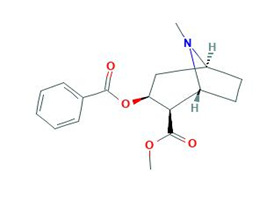
Figure 3 Chemical structure of Cocaine (C17H21NO4).14
Cocaine is produced by taking the leaves of the coca plant; there are two hundred species of this coca plant, however, only two are suitable to manufacture cocaine.19 These two species contain the highest levels of cocaine, climates and soil conditions also play a major factor in the levels of cocaine found. Once the leaves have been collected they must be left to dry; if the leaves get wet they will start to rot, resulting in a loss of production and money.20 Overall there are 3 different phases to this method: 1) Extraction phase, 2) Base phase and 3) Hydrochloride phase. In phase 1, the coca leaves are added the mixture of bleach, kerosene and sulphuric acid; this is to allow the leaves to soften, to make the extraction of the paste easier.21 Phase 2 occurs when potassium permanganate is added, then followed by dilute ammonia or another alkaloid; this is to cause the cocaine base to separate and is then filtered to remove impurities.22 In the final stage, the base is left to dry to form a white powder; the base is then dissolved in hydrochloric acid, thus forming cocaine hydrochloride, the white fluffy powder known as cocaine.23 Cocaine hydrochloride can also be converted into what is known as ‘crack’; this version of the drug is crystallised, does not contain hydrochloride and is typically brown in colour. Crack cocaine is made by adding baking powder and water to the white powder; this substance is then boiled and cooled to produce the rock like substance.24 In Figure 4, the differences of cocaine and ‘crack’ cocaine can be seen. As shown in Figure 4.
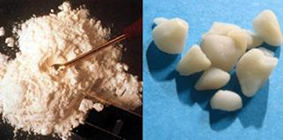
Figure 4 Cocaine Hydrochloride Vs Crack Cocaine.25
Cocaine can enter the body via 4 different ways dependent on the type of cocaine present. With cocaine hydrochloride, the substance is most commonly snorted; however, it can be ingested and also injected if dissolved in water. Crack cocaine can only be smoked, as the drug is smoked the fumes from the substance are inhaled, causing the euphoric feeling. Figure 5 on the next page shows the differences between how Cocaine is taken.25,26
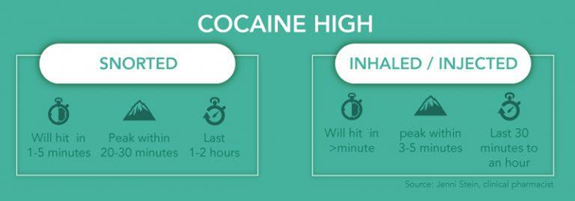
Figure 5 Differences between how Cocaine is taken.26
As stated previously, Cocaine is mainly trafficked from the jungles of Colombia, Peru, Bolivia and Venezuela; located in South America. In recent years, Brazil has also been seen as a major departure point; showing that Bolivia and Peru, located next to Brazil are producing more cocaine for the European market.27 The routes that Cocaine travels use air, land and sea; recently the route that travels across the Sahara in Africa has been abandoned due to violence located in Libya and Mali.28 This has caused Liberia and Sierra Leone to lose out on the drug trade; as these countries fall, other countries such as Nigeria and Ghana have picked up the trade; the cocaine is mainly delivered from Brazil.
In Figure 6 below shows the main cocaine trafficking. routes is bought for and which continents consume the most. The data from this study is show in Table 2.29 Figure 5 Differences between how Cocaine is taken.26
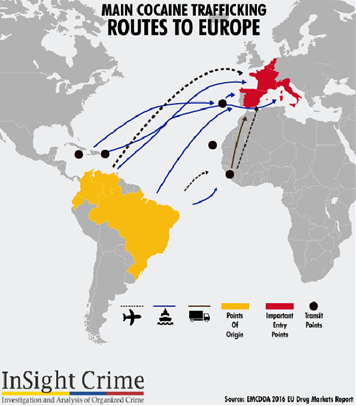
Figure 6 Major Cocaine trafficking routes to Europe.27
In 2008, a study by UNODC (United Nations Office on Drugs and Crime); showed the average retail price for a gram of cocaine in US dollars. This study is fairly old; however, it still provides basic information the price of cocaine is and which continents consume the most. The data from this study is show in Table 2.29 Figure 6- Major Cocaine trafficking routes to Europe.27
Continents |
Average retail price of 1 gm of cocaine(US$) |
Average purity of Cocaine at retail level (%) |
Value of the Cocaine market (in billions,US$) |
|
North America |
108 |
56 |
38 |
|
EU |
101 |
37 |
34 |
|
South America, Central America, Caribbean |
11 |
66 |
2 |
|
Africa |
22 |
34 |
2 |
|
Asia |
142 |
73 |
3 |
|
East and South-East Europe |
125 |
48 |
3 |
|
Oceania |
291 |
|
53 |
6 |
Table 2 Average price, purity and the value of the cocaine market for each continent
Table 2 - Average price, purity and the value of the cocaine market for each continent.
In 2008, the average retail price for 1 gram of Cocaine in the EU was US$101, when converted to British Pounds with today’s conversion rate (US$ 1.00 = £0.77).30 The average price for one gram of cocaine would have been £77.40. Cocaine itself is concealed as it is smuggled, as well as the money needed for transfers/the debt for drugs received. The cash is hidden in a small laptop case or a small suitcase, in €500 notes x 2,000 for a small laptop case, weighing in at 2.2kg. Whereas with a small suitcase, the money would potentially be in €50 x 20,000; weighing in at around 22kg. To smuggle cocaine, the techniques must be creative and unusual to allow the police/government to believe it is just a simple item. In the United States in 2011, 3 unusual techniques were discovered: a colouring book with the wax from a crayon containing heroin, a bouquet of flowers in a cardboard box when shredded and added to a solution the box dissolved into liquid heroin and hidden narcotics underneath postage stamps.
Police/government to believe it is just a simple item. In the United States in 2011, 3 unusual techniques were discovered: a colouring book with the wax from a crayon containing heroin, a bouquet of flowers in a cardboard box when shredded and added to a solution the box dissolved into liquid heroin and hidden narcotics underneath postage stamps. Adulterants more commonly known as cutting agents; can in fact change the texture and form of a drug. Adulterants are mainly used to bulk out a drug so that dealers can increase the amount of drug available. Typically, the agents used in this process have a similar mechanism to the drugs being cut and are a similar type of drug i.e. stimulant/depressant. Normally for cocaine, adulterants in drug samples collected are found to be: benzocaine and lidocaine (both anaesthetics), caffeine (similar stimulant properties to cocaine) or paracetamol (painkiller). Most of these cutting agents are easy to access and readily available to the public; by identifying these agents, an insight into specific drug gangs can be recognised.
Heroin trafficking
Heroin has been labelled as the most addictive drug in the world when compared to other hard drugs such as: Cocaine, Nicotine, Barbiturates and Alcohol.31 This substance allows the user to feel a sense of euphoria and provides momentary relief from pain and stress.32 The structure is very similar to that of morphine; heroin’s structure can be seen in Figure 7.33
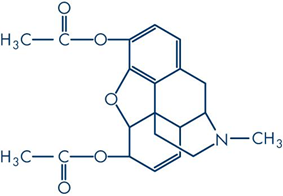
Figure 7 Chemical structure of Heroin (C21H23NO5).33
When heroin has entered the body, an enzyme found in the human serum known as acylcholine acylhdyrolase34 performs hydrolysis on the heroin molecule. This enzyme converts the drug into morphine. Once converted, the morphine binds to opiate receptors found in certain areas of the brain such as: the cerebral cortex. Figure 8 below shows the areas of the brain with opioid receptors. A theory behind this mechanism is that; as the opiate receptors are activated, there is a decrease in the release of GABA (gamma-Aminobutyric acid). This GABA molecule naturally inhibits the release of dopamine. However, if the abundance of GABA decreases, the volume of dopamine will thus increase.35 Causing the euphoric feeling described by heroin users as shown in Figure 8.
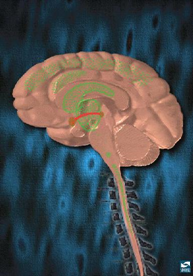
Figure 8 Opioid receptors (green dots) in the brain.35
Heroin is cultivated by growing the opium poppy in fields; these poppies are left to ripen. Once ripe, the poppy head is scored with 3-4 lines on each of the four faces, the head is then left to weep.36 The sap that comes out of the poppy is raw opium and is generally made into morphine, once collected the sap is left to dry.37 After the opium has dried, the substance is taken to small scale clandestine laboratories hidden in Afghanistan, it is added to a vat of boiling water and calcium hydroxide (to allow precipitation to occur). Whilst the vat is boiling, clear liquid starts to form on the surface, this clear liquid is morphine.38 A binding solution- normally ammonium chloride is added to the morphine and then replaced back into the vat. After filtration, the residue is left to dry resulting in the morphine base- a coffee coloured rock like substance. In later stages the morphine base is converted to morphine hydrochloride by the addition of hydrochloric acid and activated charcoal ready to harvest heroin.39 The next two stages are very complex, involving the acetylation of morphine. Acetic anhydride and water are added to a vat of the morphine hydrochloride, it is then heated to 85 degrees Celsius. Once the morphine has dissolved, activated charcoal is added to remove impurities and the water layer is poured off; sodium carbonate is added to produce a precipitation with the end result containing the heroin base, this base is then dried.40 The final step takes place by adding ethyl ether and hydrochloric acid to the base, thus allowing the heroin to precipitate and then dry.41
Heroin can have three appearances, the first is a white powder and the purity is very high; the second is a brown powder, similar to the white but less pure. Thirdly, a black rock/tar substance, this colour is due to impurities being left behind in the filtering process.42 The white and brown powder can be snorted or smoked- commonly known as ‘chasing the dragon’; however, the black substance is mainly heated to be injected straight into the veins. Figure 9 highlights the differences between the two versions of heroin.43
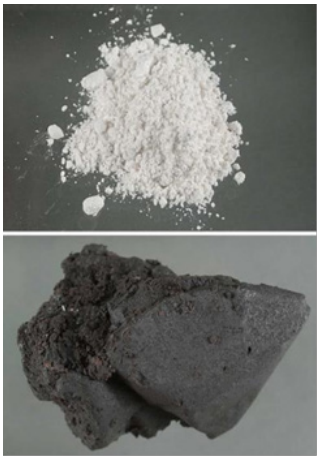
Figure 9 White powder heroin (above) Black tar heroin (below).43
Previously stated earlier that heroin is trafficked into Europe using four main routes; the traditional Balkan route, this route mainly runs from the supplier country (Afghanistan) through to Iran and then to Turkey.44 This route is the shortest and most efficient, once the heroin has reached Turkey; the drugs are split via three branches to distribute to other countries mostly by sea/land.
The second route is the Southern route; this runs across the Indian Ocean; the heroin is trafficked by sea. The route described runs from Afghanistan, along the Indian Ocean to the eastern coast of Africa and also to the centre where the Maldives and Sri Lanka are located45 on a map.
The final route is the Southern Caucasus route, this is a relatively new route and it is suggested that large amounts of opiates including heroin are shipped on ferries from Iran to Europe; via the Black Sea and through Ukraine and Moldova44 Figure 10 shows the four routes on a map.46
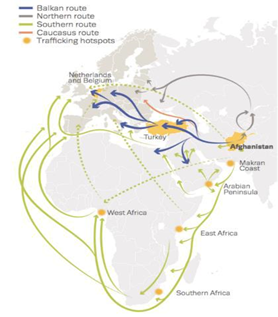
Figure 10 Map of Heroin trafficking routes.46
Using statistical analysis from the European Monitoring Centre for Drugs and Drug Addiction produced in 2018. For both white heroin and undistinguished heroin, there has been no data for the price of 1 gram since the study started in 1995 for white heroin in the UK and since 2010 for undistinguished heroin.47 Meanwhile the data for brown heroin states that the minimum price paid for 1 gram in the UK has fluctuated since its arrival in 2011. In 2011 it was stated as €34.39, since then it has increased to €48.80 with data from 2016. Using the current conversion rates for Euros into British Pounds (€1 = £0.86),48 in 2016 in the UK, typically one gram of brown heroin was £42.21. In relation to other countries, in 2016 the UK was in the top 4 countries for the highest price for 1 gram of brown heroin. Table 3 below shows the mimium prices for 1 gram of brown heroin in other European countries. Table 3.
Country |
2016 |
2015 |
2014 |
2013 |
2012 |
2011 |
Austria |
25 |
25 |
25 |
30 |
30 |
40 |
Croatia |
39 |
39 |
39.4 |
40 |
40 |
27 |
Czech Republic |
18.5 |
25.6 |
36.3 |
26.9 |
31.8 |
40.7 |
Denmark |
66.7 |
54 |
54 |
N/A |
33.7 |
33.7 |
Italy |
35 |
35.41 |
34.26 |
35.5 |
35.5 |
35.5 |
Turkey |
5.06 |
3.11 |
3.57 |
2.71 |
4 |
4 |
United Kingdom |
48.8 |
55.2 |
49.54 |
50.17 |
37.01 |
34.39 |
Table 3 Table of brown heroin prices in Euros for different countries
Heroin, just like cocaine is smuggled into Europe using obscured techniques; there are many common ways such as taping the drugs to the body in bags and then hiding these bags with garments- this technique is mainly used to smuggle drugs through an airport.49–56 More recently, a veterinarian from Colombia; concealed plastic bags of heroin inside live puppies to then be imported to the US.57–63 Even chess boards have been used to disguise and hide the heroin, in 2014; £550,000 worth of 100% purity heroin was discovered inside the fabric of 10 board games.64
Adulterants are added to heroin in a similar way to cocaine, however, for heroin the most common adulterants used are: caffeine (stimulant), procaine (anaesthetic), paracetamol (painkiller) and chloroquine (antimalarial drug).65 These four substances are added to the heroin powder, to not only bulk the drug out; but also, to disguise a low purity. Chloroquine has a crystallised appearance similar to that of heroin, this substance could possibly be used to give fake heroin instead of the real thing. More recently, drug suppliers have started cutting their heroin with fentanyl; this is a deadly drug, between 30-50 times stronger than that of heroin. Fentanyl is a very powerful opiate; in the US alone, the amount of overdose deaths caused by fentanyl has increased from 4,223 in 2014 to 18,335 in 2016, the death increase has quadrupled since 2014.66 Figure 1166 shows the spike in the number of deaths involved in heroin and fentanyl overdose over the past 5 years.
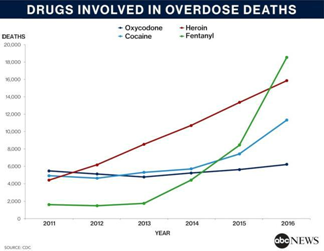
Figure 11 Number of deaths involved in heroin and fentanyl overdose between 2011 and 2016.66
Due to the high potency of heroin and fentanyl alone; when mixed together the substances creates a killer drug. Both drugs have depressant effects but also give the user the addictive euphoric feeling; due to the drowsy feeling, the more fentanyl you have, the less your body feels an urge to breathe, thus causing an overdose and then death.67
Do drugs affect the crime rate?
Drug-induced crime, the term for offenses related to the use of drugs.49 The argument over ‘does drug use increase the crime rate?’ has always caused a lot of tension throughout England due to lack of sufficient evidence to prove this proposition is correct. The term drug-induced crime has been split into 4 groups: Economic-compulsive, Psychopharmacological, Systemic and Drug law offences.
Typically, the term ‘Economic-compulsive crime’ relates to crimes committed in an attempt to obtain money/drugs to support drug use.50 The use of the word compulsive implies this type of crime, makes the person feel compelled to commit the crime despite the effects.51 Most of the time, the person(s) involved in this type of crime, commit low-level offences such as shoplifting and/or burglary.52 As previously stated these lines of offences are to obtain drugs via money/goods stolen,2 not only is it goods that are stolen to be sold on, but also forgery of prescriptions and theft of pharmacies. This is to allow the user to still feel a similar sensation to the drug they normally take. Theft and shoplifting can also be linked to psychopharmalogical crimes as when a person ‘feels high’ they do not realise what they are doing.
The second category- Psychopharmacological crime refers to any crime committed whilst under the influence of a psychoactive substance, in this case any illicit drug.50 The offences committed are normally under the title of violent behaviour. To be able to understand an association between the use of illicit drugs and violent behaviour; the pharmacology of certain drug types i.e. stimulants, opiates.53 Some drugs can inhibit/stimulate certain receptors found in the brain-normally the limbic system,54 thus controlling some emotional responses; which could potentially lead to anger and violence.
The third category- Systemic crime signifies violence that is committed within the illegal drug markets, with not only the supply of the drugs but also the distribution and use.50 Due to this violence, many of the people involved in the drug trade are at risk of death or serious injury; this violence is mainly caused by competition between certain sellers.68 The competition is mainly due to the quantity of drugs sold but can also refer to the territory i.e. one gang sells on one street only and no other gang is allowed to sell there. A lot of this crime relates to corruption within high-level officials; if the officials are not there to protect the drug gangs from police/non-corrupt government officials, insecurity forms in the minds of individual traffickers as they now need to find additional support.
Lastly, the final category is drug law offences, this section of drug-induced crime is obvious in its relation to the violation of drug legislations,50 such as The Misuse of Drugs Act 1971 plus the amendments and the Drug Trafficking Act 1994; as well as other legislations for other countries other than the UK. The main crimes committed in this section are typically: the use of drugs, possession of drugs, supply of drugs and trafficking. Typically, in the UK; drug-related crimes are hard to distinguish from just general crimes. Drug law offences are the only drug-induced crime that the UK government produce in the National statistics, this could potentially be to avoid the subjection that certain crimes are committed when under the influence of drugs; as there is not sufficient evidence to prove so. In 2017, the Office for National Statistics; released their annual report, in the appendix, data on the trafficking of drugs and possession was ascertained.69 Shown in Table 4 below is the data recovered.
Year |
|||||||
Offence committed |
April ’10 to March ‘11 |
April ’11 to March ‘12 |
April ’12 to March ‘13 |
April ’13 to March ‘14 |
April ’14 to March ‘15 |
April ’15 to March ‘16 |
April ’16 to March ‘17 |
Trafficking of drugs |
32,336 |
31,316 |
29,746 |
29,348 |
27,362 |
25,795 |
25,224 |
Possession of controlled drugs (excluding cannabis) |
38,711 |
36,453 |
34,596 |
34,066 |
32,225 |
29,134 |
26,607 |
Possession of cannabis |
1,60,733 |
1,60,203 |
1,42,627 |
1,33,604 |
1,10,295 |
93,180 |
83,462 |
Other drug offences |
1,142 |
1,127 |
1,034 |
1,198 |
777 |
597 |
1,049 |
Table 4 Drug offences committed in England and Wales from April 2010 to March 201769
From the table above, a clear trend in the number of offences committed that are associated with the trafficking of drugs is observed; as the years increase, the number of trafficking offences decrease from 32,336 in April ’10-March ’11 to 25,224 in April ’16-March ’17. This could be due to tighter drug laws and penalties influenced through the amendments to the Misuse of Drugs Act 1971,70 this act covers both medicinal drugs as well as substances with no medicinal use. The government plays a big part in this decrease of trafficking as they are more aware of the routes the drugs infiltrate the country. On the other hand, any other drug offences not stated in the table i.e. supply, has fluctuated from 2010 to 2017. These types of crime gradually decreased, until April ’16 when a rise was established.
Drug legislation's are seen throughout copious countries, these legislation's include: use, possession, supply and trafficking). Each country has their own way of enforcing the law and the size of the penalties faced for each offence.71 Table 5 shows the differences in the penalty liable for possession of drugs for personal use.
Table 4 Drug offences committed in England and Wales from April 2010 to March 2017.69 Table 5 Differences in the penalties for possession of drugs for different countries in Europe.71
Country |
Penalty for possession of drugs for personal use |
UK |
Dependent on Class of drug, either imprisonment and/or a fine |
Germany |
Either imprisonment for 5 years or a fine |
Croatia |
No imprisonment, fine of EUR 650- 2,600 |
Netherlands |
1-year imprisonment for List 1 drugs, 1-month imprisonment for List 2, if 5 grams or less of cannabis is found on person then they are not breaking the law |
Italy |
No imprisonment or fine, administrative sanctions i.e. suspension of driving license dependent on the type of drug (either List 1 and 3 or List 2 and 4) |
Estonia |
Administrative detention for up to 30 days or a fine of EUR 800 |
Sweden |
Up to 3 years imprisonment, unless the type of drug/quantity is minor then the penalty is a fine or up to 6 months imprisonment |
Table 5 Differences in the penalties for possession of drugs for different countries in Europe71
As highlighted in the table above, the drug laws across Europe are very different; they do not all follow the same structure. For example: in the UK the possession of ≥5 grams of cannabis results in a maximum penalty of 5 years imprisonment and/or a fine of £2,500.72 However, in the Netherlands; possession of ≥5 grams of cannabis results in no penalty. Due to this inequality of penalties; more drug offences for specific drugs can be observed in different areas of the EU. In 2018, EMCDDA released a statistics bulletin on drug law offences, this encased numerous sections such as: price, purity, legislations, drug-related infectious diseases and deaths due to overdose.73
Specifically, for heroin offences (possession and supply) using the countries previously examined above, the top 4 countries with the highest number of heroin offences in 2016 were: 1) UK with 11681 offences, 2) Germany with 1165 offences, 3) Italy with 5376 offences and Croatia with 150 offences.73 Estonia, Sweden and Netherlands showed no data for any heroin offences; Estonia itself has a very poor drug legislation with only minor penalties, this could be an explanation for the results showing no data, as maybe the government is more lenient towards substance abuse.
Previous research from 2013, founded at the University of Essex; links into estimates of drug-related crime,74 only estimates are used as it is very difficult to isolate crime committed due to a direct impact of drugs and also crime that has drug influences but also is motivated by other factors i.e. money, emotions. The data from this report was extracted from the Arrestee Survey and Offending Crime and Justice Survey (gathered from England and Wales). This report gathered the data and then used this information to create estimates of how many particular crimes i.e. shop theft and violent crimes were undertaken by either a heroin user, cannabis only user or a cannabis only supplier. Through empirical associations; two main tables of data were produced; the first table suggests that each drug free user is a crime-free counterfactual. Whereas, the second table assumes that if drugs were not in the equation, drug-users and non-drug users would have the same offending levels. Upon comparison, the data falls by 13% for drug-related crime in heroin users; as well as, volume crime falling between 20-80%.
In the U.S. crime is a major problem especially due to the lifestyle associated with drug users, a study in from 1997 by the ONDCP (Office of National Drug Control Policy) obtained data through the National Household Survey on Drug Abuse.75 The information displayed, showed that in the past year (1997) drug users were 16 times more likely to commit larceny or theft than non-users. In the same report there was a section on arrestees testing positive for drugs; the data attained was from both males and females in 1998. 35 cities were used in this study, for males the highest percentage of arrestees testing positive for drugs was 78.7% (Philadelphia), whereas for females the highest percentage was 82.1% (New York). Another report from the Bureau of Justice Statistics in 1994 stated that 17% of prison inmates in 1991 reported that they committed their crimes to obtain money to buy drugs.75 This relates to the economic-compulsive crimes stated earlier.
This literature review neither agrees or disagrees with the title of this review; throughout the research gathered, it became evident that statistics on both criminal activity and whether the criminal was under the influence of drugs were very limited and difficult to find. Some statistics were used, however the evidence gathered cannot be stated as conclusive to link the crime rate to drugs specifically in the UK/EU due to the lack of data provided. The information that was gathered, shows a small link between crime, criminals under the influence of drugs and criminals not under anything; specifically, money crimes i.e. robbery for drug money. Lack of information was accumulated to try and establish a link between the U.S. crime rate and drugs; the research discovered showed that drugs were a factor that effects the crime rate. However, because the research was founded between 1994-1998; this does not give a clear retrospective of today’s society.
As discussed, the cocaine and heroin trafficking systems cause many problems; not just for the users but also the government; both drugs are readily available in most countries across the world and both can cause serious side effects by themselves as well as the addition of toxic adulterants. Consequently, any member of the public can easily get their hands on them, to then distribute or use themselves; especially in the US, more information needs to be reputed specifically about the use of fentanyl as an adulterant in heroin; as an excessive amount of people are dying as a consequence of this powerful painkiller.
Overall, the crime rate has other external influences, with drugs potentially only being one out of many; as well as this, different studies interpret the crime/drug relationship varyingly, which results in less accurate data. Ultimately, until further research is done, a definite answer on this topic cannot be stated.
None.
There is no conflict of interest.

©2020 O’Hagan, et al. This is an open access article distributed under the terms of the, which permits unrestricted use, distribution, and build upon your work non-commercially.